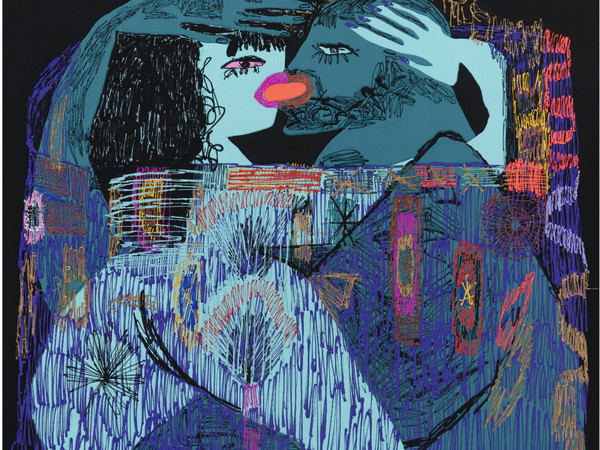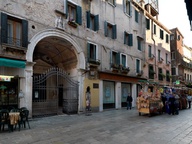Summer Wheat. KissandTell

Summer Wheat, Lovers, 2023. Acrylic paint and gouache on aluminum mesh, 238.8 x 172.7 cm.
From 09 Giugno 2023 to 14 Luglio 2023
Milan
Place: Fondazione Mudima
Address: Via Tadino 26
Times: Monday to Friday 11am - 1 pm / 3 - 7 pm
Ticket price: Free entrance
Telefono per informazioni: +39 02.29409633
E-Mail info: info@mudima.net
Official site: http://www.mudima.net
Summer Wheat’s (American, born 1977) Kiss and Tell at Fondazione Mudima in Milan, features a series of new works furthering Wheat’s exploration of mirroring and themes of vanity, visibility, and love.
Wheat’s practice is informed by drawing—where line as a foundational element allows for layers of high key color to activate the space. Using her unique method of pushing medium through the back and onto the front of screen surfaces—positioned somewhere between painting and textile—she depicts intertwined bodies and a smattering of everyday objects that reform histories depictions of women. In her practice, Wheat is influenced by both ontological and art historical forerunners, citing Leonardo da Vinci (Italian, 1452–1519), Rembrandt (Dutch, 1606–1669), Edgar Degas (French, 1834–1917), and Andy Warhol (American, 1928–1987), and concepts connected to intimate, universal, and cosmic space, mirroring, nature, and love. Wheat’s contained worlds foreground female figures and signal the artist’s broader aim to refocus histories lens.
The reflection in Wheat’s new work is less about a one-to-one mirroring and more akin to art historian Cristina Albu’s description in her 2016 book Mirror Affect: Seeing Self, Observing Others in Contemporary Art, where she eloquently describes mirroring in art in the latter part of the twentieth century as cultivating “asymmetrical relations between reflection and visual representation, self and others, personally assumed roles and more or less imposed social roles.” Wheat’s commitment to activating forms and methods of reflection joins the kind of direct mirroring associated with the theme of water present in her 2020 exhibition Blood, Sweat, and Tears (labor, self-reflection, nourishment) at Kemper Museum of Contemporary Art in Kansas City, Missouri. Re- flective elements in this new series are additionally attuned to dismantling historic social constructs surrounding gender representation in art. The electrified lines in Wheat’s work trace this labyrinth of female representation in the lineage of art history—a vibrating timeline with undulating curves and a pulsing electric palette replacing a straight, monochromatic, symmetrical narrative.
The Vanity series comprises large-scale paintings of women crouched over their vanities. The way their bodies are positioned inside the frame—seated with their torsos reaching through their angular legs and feet that par- allel the sides of the painting—make them appear to be in a stage of the yoga position dwi hasta bhujasana or the two hands and arms posture, which requires a tremendous amount of strength. This representation isn’t new to Wheat who has historically created compositions in which there has been a strong balance between the rep- resentation and abstraction of her figures. The women also are rendered to be in complete and utter control of their surroundings. These women are identical in line, form, composition, and subjects. The colors used in each painting of the figures change drastically as in Ruby and Magenta (both 2022), similar to the vibrant bar scenes of nineteenth-century painters Henri de Toulouse-Latrec (French, 1864–1901), Degas, and Édouard Manet (French, 1832–1883). The repeated image with changing colors also references Warhol’s serial images. Instead of considering them part of a mechanistic practice as in Warhol’s “factory,” Wheat sees these repeated images of women as a mirroring, recognizing that as we are “taking ourselves in [visually] over and over again [we are] changing every day,” creating a break in the Warholian repetition of the image/self of the 1960s.
[...] In the Lovers series the compositions of the embracing figures create a type of physical mirroring, where the silhouettes of the bodies flow into one other. The vanity with the palettes, brushes, compacts, and other accoutrements transforms into a site of nature, alluding to an architecture that is more personal.
Wheat’s touching upon all of these references presents a body of work that is both reflective and transformative in the way they cast back changing societal perceptions and historical representations. The vanity, the mirror, the table, and the embrace anchor swirling relevant topics of gender, societal and social perceptions and expecta- tions, and power in the invited, intimate space. She guides a progress of life experiences that have been depicted in art for centuries in the Western world into scenarios where women occupy the foreground and direct the gaze, their reflections, and their spaces. The power is in working through these perceived scenes in the present, and [...] Wheat is keenly aware that “the past is—will always be—as much a work in progress as the future.” Occupying and assimilating historical spaces is Wheat’s key to revisioning their critical relevance and to finding that sweet spot where she can make space for new dialogue.
Wheat’s practice is informed by drawing—where line as a foundational element allows for layers of high key color to activate the space. Using her unique method of pushing medium through the back and onto the front of screen surfaces—positioned somewhere between painting and textile—she depicts intertwined bodies and a smattering of everyday objects that reform histories depictions of women. In her practice, Wheat is influenced by both ontological and art historical forerunners, citing Leonardo da Vinci (Italian, 1452–1519), Rembrandt (Dutch, 1606–1669), Edgar Degas (French, 1834–1917), and Andy Warhol (American, 1928–1987), and concepts connected to intimate, universal, and cosmic space, mirroring, nature, and love. Wheat’s contained worlds foreground female figures and signal the artist’s broader aim to refocus histories lens.
The reflection in Wheat’s new work is less about a one-to-one mirroring and more akin to art historian Cristina Albu’s description in her 2016 book Mirror Affect: Seeing Self, Observing Others in Contemporary Art, where she eloquently describes mirroring in art in the latter part of the twentieth century as cultivating “asymmetrical relations between reflection and visual representation, self and others, personally assumed roles and more or less imposed social roles.” Wheat’s commitment to activating forms and methods of reflection joins the kind of direct mirroring associated with the theme of water present in her 2020 exhibition Blood, Sweat, and Tears (labor, self-reflection, nourishment) at Kemper Museum of Contemporary Art in Kansas City, Missouri. Re- flective elements in this new series are additionally attuned to dismantling historic social constructs surrounding gender representation in art. The electrified lines in Wheat’s work trace this labyrinth of female representation in the lineage of art history—a vibrating timeline with undulating curves and a pulsing electric palette replacing a straight, monochromatic, symmetrical narrative.
The Vanity series comprises large-scale paintings of women crouched over their vanities. The way their bodies are positioned inside the frame—seated with their torsos reaching through their angular legs and feet that par- allel the sides of the painting—make them appear to be in a stage of the yoga position dwi hasta bhujasana or the two hands and arms posture, which requires a tremendous amount of strength. This representation isn’t new to Wheat who has historically created compositions in which there has been a strong balance between the rep- resentation and abstraction of her figures. The women also are rendered to be in complete and utter control of their surroundings. These women are identical in line, form, composition, and subjects. The colors used in each painting of the figures change drastically as in Ruby and Magenta (both 2022), similar to the vibrant bar scenes of nineteenth-century painters Henri de Toulouse-Latrec (French, 1864–1901), Degas, and Édouard Manet (French, 1832–1883). The repeated image with changing colors also references Warhol’s serial images. Instead of considering them part of a mechanistic practice as in Warhol’s “factory,” Wheat sees these repeated images of women as a mirroring, recognizing that as we are “taking ourselves in [visually] over and over again [we are] changing every day,” creating a break in the Warholian repetition of the image/self of the 1960s.
[...] In the Lovers series the compositions of the embracing figures create a type of physical mirroring, where the silhouettes of the bodies flow into one other. The vanity with the palettes, brushes, compacts, and other accoutrements transforms into a site of nature, alluding to an architecture that is more personal.
Wheat’s touching upon all of these references presents a body of work that is both reflective and transformative in the way they cast back changing societal perceptions and historical representations. The vanity, the mirror, the table, and the embrace anchor swirling relevant topics of gender, societal and social perceptions and expecta- tions, and power in the invited, intimate space. She guides a progress of life experiences that have been depicted in art for centuries in the Western world into scenarios where women occupy the foreground and direct the gaze, their reflections, and their spaces. The power is in working through these perceived scenes in the present, and [...] Wheat is keenly aware that “the past is—will always be—as much a work in progress as the future.” Occupying and assimilating historical spaces is Wheat’s key to revisioning their critical relevance and to finding that sweet spot where she can make space for new dialogue.
SCARICA IL COMUNICATO IN PDF
COMMENTI

-
 Dal 31 gennaio 2024 al 04 maggio 2025
Fermo | Palazzo dei Priori
Dal 31 gennaio 2024 al 04 maggio 2025
Fermo | Palazzo dei Priori
-
 Dal 20 dicembre 2024 al 04 maggio 2025
Fermo | Palazzo dei Priori
Dal 20 dicembre 2024 al 04 maggio 2025
Fermo | Palazzo dei Priori
-
 Dal 20 dicembre 2024 al 04 maggio 2024
Gorizia | Palazzo Attems Petzenstein
Dal 20 dicembre 2024 al 04 maggio 2024
Gorizia | Palazzo Attems Petzenstein
-
 Dal 18 dicembre 2024 al 18 dicembre 2024
Venezia | Museo Correr
Dal 18 dicembre 2024 al 18 dicembre 2024
Venezia | Museo Correr
-
 Dal 14 dicembre 2024 al 02 marzo 2025
Palermo | Palazzo Abatellis
Dal 14 dicembre 2024 al 02 marzo 2025
Palermo | Palazzo Abatellis
-
 Dal 12 dicembre 2024 al 23 febbraio 2025
Roma | Palazzo Altemps
Dal 12 dicembre 2024 al 23 febbraio 2025
Roma | Palazzo Altemps


